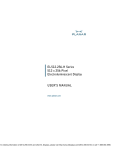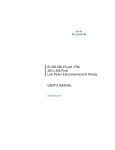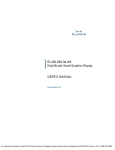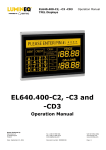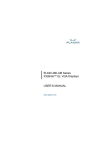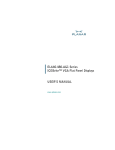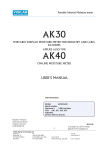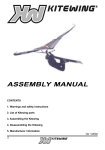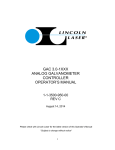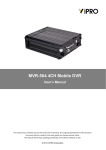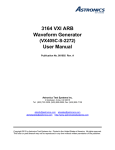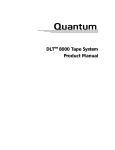Download EL512.256-H2-FRB
Transcript
EL512.256-H Series 512 x 256 Pixel Electroluminescent Display USER’S MANUAL www.planar.com Revision Control Date Description April 1995 Document number PI02552 Ver 1 June 2004 Document number 020-0354-00A Contents Product Profile ............................................................................................................................................................3 EL Technology.............................................................................................................................................................3 Electrical Characteristics..........................................................................................................................................4 Connector Layout .................................................................................................................................................4 Input to the Display..............................................................................................................................................5 Control Basics .........................................................................................................................................................6 Power Input.............................................................................................................................................................6 Signal Inputs ...........................................................................................................................................................6 Optional Grounding.............................................................................................................................................6 Connectors ..............................................................................................................................................................6 Input Specifications..............................................................................................................................................7 Display Features .........................................................................................................................................................7 Video Data Input ...................................................................................................................................................7 Two Bit Parallel Data ............................................................................................................................................8 Display Enable........................................................................................................................................................8 Brightness Control ................................................................................................................................................8 Low Power Mode ..................................................................................................................................................8 Self Test.....................................................................................................................................................................8 Installation and Handling........................................................................................................................................9 Video Input Timing.............................................................................................................................................10 Setup and Hold Timing .....................................................................................................................................10 Operational Specifications ...................................................................................................................................11 Environmental......................................................................................................................................................11 Reliability................................................................................................................................................................11 Safety.......................................................................................................................................................................11 Optical.....................................................................................................................................................................12 Display Colour .................................................................................................................................................12 Optional Filter .................................................................................................................................................12 Mechanical Characteristics...................................................................................................................................13 Display External Dimensions...........................................................................................................................13 Display Viewing Area Characteristics...........................................................................................................13 Description of Warranty ........................................................................................................................................18 Easy to Use .................................................................................................................................................................18 Support and Service................................................................................................................................................19 Ordering Information .............................................................................................................................................19 Figures Figure 1. EL Technology......................................................................................................................................3 Figure 2. Connector Layout ...............................................................................................................................4 Figure 3. Video Input Timing ............................................................................................................................9 Figure 4. Setup and Hold Timing...................................................................................................................10 Figure 5. Viewing Area Chracteristics ..........................................................................................................14 Figure 6. Front View, without Mounting Frame.......................................................................................14 Figure 7. Back and Side Views.........................................................................................................................15 Figure 8. Back and Side Views, with Aluminum Mounting Frame.....................................................16 Figure 9. Back and Side Views, with FRB Steel Mounting Frame .......................................................17 Tables Table 1. Input to the Display .............................................................................................................................5 Table 2. Connectors..............................................................................................................................................6 Table 3. PS1 .............................................................................................................................................................7 Table 4. Input Specifications .............................................................................................................................7 Table 5. Video Input Timing ............................................................................................................................10 Table 6. Setup and Hold Timing.....................................................................................................................10 Table 7. Environmental Characteristics.......................................................................................................11 Table 8. Optical Characteristics ......................................................................................................................12 Table 9. Display External Dimensions..........................................................................................................13 Table 10. Display Viewing Area Characteristics........................................................................................13 Product Profile The EL512.256–H series displays are rugged, high resolution electroluminescent (EL) flat panel displays. They replace the bulky CRT in control and instrument product designs. They feature an integrated DC/DC converter, and their compact dimensions save space that can allow addition of features or reduction in overall size. They are designed to work in extreme environments and the crisp display is viewable at wide viewing angles both in horizontal and vertical directions. Their ease of installation reduces system integration costs. The EL512.256–H is a 512 column by 256 row flat panel display with a 1:1 pixel aspect ratio. The digital flat panel interface is designed to match the needs of most systems. The displays may be driven at frame rates up to 75 Hz. The EL512.256–H displays require +5 Vdc and +11…+30 Vdc power input and four basic input signals to operate: 1. Video Data or pixel information 2. Video Clock, pixel clock, or dot clock 3. Horizontal Sync 4. Vertical Sync EL Technology Figure 1. EL Technology. A display consists of an electroluminescent glass panel and a mounted circuit board with control electronics. The EL glass panel is a solid-state device with a thin film luminescent layer sandwiched between transparent dielectric layers and a matrix of row and column electrodes. The row electrodes, in back, are aluminium; the column electrodes, in front, are transparent. The entire thin film device is deposited on a single glass substrate. The glass panel is mounted to an electronic circuit assembly board (ECA) with an elastic spacer. The ECA is connected to the EL glass panel with soldered lead frames. The result is a flat, compact, reliable and rugged display device. 2 EL512.256-H Series Operations Manual (020-0354-00A) In EL512.256–H series displays, the 512 column electrodes and 256 row electrodes are arranged in an X-Y formation with the intersecting areas performing as pixels. Voltage is applied to both the correct row electrode and the correct column electrode to cause a lit pixel. Operating voltages required are provided by an integral DC/DC converter. Electrical Characteristics Connector Layout Fig 2. Input Connectors and Jumpers and their location. 3 EL512.256-H Series Operations Manual (020-0354-00A) Input to the Display Table1. Input to the Display. Pins Signal Symbol Description J1(Data/power input connector) 1, 2 Voltage Vcc2 3, 4 Voltage Vcc1 5 6, 8, 10 7 Reserved Ground Two-bit data GND TVID 9 Vertical Sync VS 11 Horizontal Sync HS 13 Video Clock VCLK 15 Video Data VID 12, 14, 16 Ground GND Supply voltage (+11…+30V) converted to required internal high voltages (see J2). Supply voltage (+5 V) for the logic (see J2). Reserved, do not connect. Signal return. Second data input for two bit parallel mode. The TVID input is for odd columns and the VID for even ones. The vertical sync signal VS controls the vertical position of the picture. The horizontal sync signal HS controls the internal row counter and the horizontal position of the picture. The VCLK signal shifts data present on the VID and TVID lines into the display system. VCLK is active on the rising edge. Signal that supplies the pixel information to the system. Signal return. J2 (Optional power input connector) 1 Voltage Vcc2 2, 3 Ground GND 4 Voltage Vcc1 5 Low Power _LOWPWR 6 Enable ENABLE Same as J1, Pins 1, 2 (not necessary to connect if power is supplied via J1). Same as J1 Pins 6, 8, 10, 12, 14, 16 (not necessary to connect if power is supplied via J1). Same as J1 Pins 3, 4 (not necessary to connect if power is supplied via J1). The power consumption of the display is lowered to LOWPWR values if the _LOWPWR is low, internally pulled high if left disconnected. The operation of the display unit is disabled if the ENABLE input is low, internally pulled high if left disconnected. J3 (Optional control input connector) 1 2 3, 4 4 Luminance Pot.1 Luminance Pot.2 Reserved LUMPOT1 LUMPOT2 EL512.256-H Series Operations Manual (020-0354-00A) Input for external luminance control (see page 8). Can be left disconnected. Input for external luminance control. Can be left disconnected. Reserved, do not connect. Control basics The EL panel has 512 transparent column electrodes crossing 256 row electrodes in an X-Y fashion. Light is emitted when an AC voltage is applied at a row-column intersection. The display operation is based on the symmetric, line at a time data addressing scheme which is synchronized by the external VS, HS, and VCLK input signals. The internal control signals and the high voltage pulses for the column and row drivers are generated internally by the control electronics. All control signal inputs are HCT compatible with pull-up resistors. Power Input The required supply voltages for the display are +5 Vdc (Vcc1) for the logic and +11…+30 Vdc input (Vcc2) for the integrated DC/DC converter. The high voltages needed for driving the display are generated by the DC/DC converter from the Vcc2 input voltage. The input voltages can be connected either through J1 or J2. Signal Inputs Connector J1 contains input for the video signals, connector J2 contains two control inputs and connector J3 contains input for external luminance control. The signals on J2 and J3 that are not used can be left disconnected. Optional Grounding In order to improve the EMC properties of the display system, there is an option for the customer to tie together the signal ground of the display and the chassis of the user device. For this purpose the four corner mounting nuts are each connected to the signal ground with 10 nF / 50 V capacitors. When using this option, please be aware of the possible risk of lowered isolation strength of the device and possible generation ground loops. Connectors Table 2. Connectors. 5 J1 16-pin header Mating Locking clip ODU 511.066.003.016 or eq. ODU 517.065.003.016 or eq. ODU 511.065.716.700 or eq. J2 6-pin header Mating Protector Hirose DF1–6P–2.5DSA or eq. Hirose DF1–6S–2.5 R 24 or eq. Hirose DF1–6A 1.33 J3 4-pin header Mating Protector Hirose DF1–4P–2.5DSA or eq. Hirose DF1–4S–2.5 R 28 or eq. Hirose DF1–6A 1.33 EL512.256-H Series Operations Manual (020-0354-00A) Table 3. PS1. Position Name Function 1 SELFTST Self test function is selected, if theSELFTEST jumper is OFF. In self test, the input video data at VID and TVID inputs are displayed asynchronously without any other input signals. The Two-bits-parallel mode is selectedif this jumper is OFF (see page 8) Reserved, do not insert jumper. Reserved, do not insert jumper. 2 DCONFIG 3 reserved 4 reserved When shipped from the factory, jumpers PS1/1 and 2 are set. Input Specifications Table 4. Input Specifications. Parameter Logic input HIGH Logic input LOW Logic supply voltage Logic supply current at 5V Display Supply voltage Supply current at 12V Supply current at 12V (LOWPWR) Power consumption 5V/12V Power consumption 5V/12V (LOWPWR) Symbol Min. Typ. Max. 5.0V — — 0.5A 0.3A 0.8V 5.25V 0.2A 30V 0.9A 0.5A 6W 12W 4W 7W 2V Vcc1 Icc1 Vcc2 Icc2 Icc2 4.75V — 11V Absolute min./max. Vcc1 + 0.5V abs. max. –0.5V abs. min. 6V abs. max. 33V abs. max. Operating conditions: Frame rate 70 Hz. ambient temperature 25°C. Note: Absolute maximum ratings are those values beyond which damage to the device may occur. The minimum and maximum specifications in this Operations Manual should be met, without exception, to ensure the longterm reliability of the display. Planar does not recommend operation of the display outside these specifications. Display Features Video Data Input Four input signals are needed for video input. VS signal marks the topmost row, HS envelopes the pixels in one row and VCLK indicates the valid pixel data. The visible pixels in a row are the last 512 pixels before the fall of the HS. The topmost row displayed is the first HS HIGH time ending after the rising edge of VS. If HS is running continuously, the rising edge of the VS can be simultaneous to the previous falling or rising edge of the HS. See details on the timing as well as setup and hold timing on pages 9 and 10. 6 EL512.256-H Series Operations Manual (020-0354-00A) Two Bit Parallel Data To reduce the input data frequency the video data can be input two bits per clock cycle. The two data inputs are organized so that the data for the odd columns, numbered from left to the right at the viewers side, is input at the TVID (J1/ pin 7) and the data for the even columns at VID (J1/ pin 15). The two bit parallel mode is selected by removing jumper 2 of the pin strip PS1. Display Enable The display can be totally shut off for screen save or power reduction by a LOW sate in the ENABLE control input (J2/pin 6). When disabled, the display stops scanning and only the DC/DC converter remains functional lowering the power consumption to below 2 W. In normal operation the ENABLE input should be pulled HIGH or left disconnected (internal pull-up). Brightness Control The brightness of the display can be adjusted (appr. between 40 and 100%) by an external 50 k Ω logarithmic potentiometer between the LUMPOT1 and LUMPOT 2 inputs (J3/pins 1 and 2). The control function is done by feeding a small DC current signal via the external potentiometer from LUMPOT1 (+5V reference voltage) to LUMPOT2. If the two inputs are left disconnected, the brightness is at its maximum level. Low Power Mode The power consumption of the display is possible to be reduced typically to 4 W by using the low power mode. This mode is selected when _LOWPOW control input (J2/5) is pulled low. In normal operation _LOWPOW should be pulled HIGH or left disconnected. In low power mode the contrast and average brightness of the display are slightly reduced. Self Test The operation of the display can be easily checked without any external signals by the self test function. Remove Jumper 1 in pinstrip PS1. Connect power to the display. All pixels of the display will be lit with the exception of the first half of the topmost row. 7 EL512.256-H Series Operations Manual (020-0354-00A) Installation and Handling The product should be mounted using the M3 insert nuts on the ECA. Beside the four corner nuts it is recommended to use also the two center nuts in the mounting, if the vibration or shock stress is severe. Before touching the display, necessary precaution must be taken to prevent application of static charges on the display from the operator or tools. The display is made of glass material and should be handled with proper care. Do not drop the display or allow hard objects to strike its surface. NOTE: For trouble-free data transfer a maximum cable length of 300 mm (12 in.) from data transmitter to display input connector is recommended. If longer cables up to 2m (80 in.) length are needed, a serial resistor of appr. 47 Ω could be placed at each of the four signal line outputs of the transmitter in order to lower signal reflections. Electrostatic Caution: Planar display use CMOS and power MOS-FET devices. These components are electrostatic sensitive. Unpack, assemble and examine this assembly in a staticcontrolled area only. When shipping use packing materials designed for protection of electrostatic-sensitive components. Warning: The product generates potentially dangerous voltages capable of causing personal injury (high voltage pulses up to 195 Vac). Do not touch the display electronics during operation! Fig 3. Video Input Timing. 8 EL512.256-H Series Operations Manual (020-0354-00A) Video Input Timing Table 5. Video Input Timing. Description Min 1 T1 Vertical Front Porch T2 VS HIGH/LOW time 2 T3 Vertical Period VS frequency typ Max Unit 100 1 256 tHS + T1 Description Min T4 HS setup to VS T5 HS hold from VS T6 HS Low Time 3 T7 HS High Time 4 T8 HS period (tHS) 1 3 4 512 50 µs tVCLK 70 75 Typ Unit Hz tVCLK µs tVCLK tVCLK µs 512 Notes: 1 This time is needed to display the last row and to change the frame. 2 Only rising edge is used. 3 Video Clock VCLK should be kept running. 4 The values for two bit parallel mode are 256/256 tVCLK. The number of VCLK pulses during HS high time should be even. Setup and Hold Timing Figure 4. Setup and Hold Timing. Table 6. Setup and Hold Timing. 9 Symbol Description Min tVCLK VCLK period VCLK frequency 33ns EL512.256-H Series Operations Manual (020-0354-00A) Max 30 MHz Operational Specifications Environmental Table 7. Environmental Characteristics. Temperature Operating H2 H3 0…+55°C –25…+65°C Non-operating –40…+75°C Operating Survival H2 –20…+65°C (no permanent damage) H3 –40…+65°C (no permanent damage) Test duration 24 h at temperature extremes (without condensation) Humidity Relative Humidity Damp Heat +40°C, 93% RH, Operating (IEC 68-2-3) +25…+55°C, 95% RH, Non operating (IEC 68-2-30) Altitude Operating 15,000 m (50,000 ft.) above sea level Vibration 20…500 Hz ASD level 0.05 G2/Hz Random vibration wide band IEC 68–2–36, Test Fdb Shock Magnitude Duration Number of shocks 100 G 4 ms (half sine wave) 18 (3 on each of the 6 surfaces) IEC 68-2-27, test Ea Reliability MTBF > 30,000 h @ 25°C Safety The display will not inhibit the end product from obtaining the following specification: UL544 10 EL512.256-H Series Operations Manual (020-0354-00A) Optical Determined at 70 Hz frame rate at room temperature. Display Colour Wide band amber (Zn:Mn) Table 8. Optical Characteristics. Areal Luminance On Luminance (typ) 65 cd/m2 (19 fL) On Luminance (min.) 45 cd/m2 (13 fL) Measured at the center and the four corners of the screen. Luminance Non-uniformity Maximum 35% = (1– min. luminance/max luminance) x 100. Maximum difference between any two of five points (center and four corners) 20% 10,000 h Luminance Variation (Time) Maximum Luminance Variation (Temperature) Typical Maximum 10% 15% over –25…+65°C range. Viewing Angle Minimum 160° Optional Filter For best overall optical performance of the display, a neutral gray circular polarizing filter with anti-reflective coating or etch is the usual choice. This filter will make the reflective electrodes of the display darker and will improve the contrast ratio. The anti-reflective coating on the filter should face the user. 11 EL512.256-H Series Operations Manual (020-0354-00A) Mechanical Characteristics Display External Dimensions Fig. 6 shows the mechanical dimensions of a standard EL512.256–H series display unit. The display can also be delivered with optional FRA aluminium frame or FRB steel frame (see Fig. 5 and 6). Using FRB frames makes the display mounting compatible with Planar MD512.256 displays. See Ordering Information on page 19. Table 9. Display External Dimensions. Height 136 mm 5.35 in. Width 233 mm 9.17 in. Depth 16.5 mm 0.65 in. Weight 400 g 14 oz. Display Viewing Area Characteristics Table 10. Display Viewing Area Characteristics. Active Area millimeters (inches) height width 97.5 (3.84) 195.1 (7.68) height width 0.381 (0.015) 0.381 (0.015) millimeters (inches) height width 0.25 (0.01) 0.25 (0.01) Pixel fill factor 43% Pixel Matrix 512 horizontal by 256 vertical Pixel Pitch millimeters (inches) Pixel Size CAUTION: The ambient temperature of the display should not be allowed to exceed the environmental specifications (see Table 7). In most applications, an air gap of appr. 5 mm is recommended (see mechanical drawings). Some applications may require, however, a larger air gap or cooling of the display unit in the system. Note that this may slightly increase the total depth of the design. 12 EL512.256-H Series Operations Manual (020-0354-00A) Fig 5. Viewing Area Characteristics. Fig 6. Front View without Mounting Frame (standard). 13 EL512.256-H Series Operations Manual (020-0354-00A) Fig 7. Back and Side Views. Dimensions in mm. 14 EL512.256-H Series Operations Manual (020-0354-00A) Fig 8. Back and Side Views with FRA Aluminum Mounting Frame. Dimensions in mm. 15 EL512.256-H Series Operations Manual (020-0354-00A) Fig 9. Back and Side Views with FRB Steel Mounting Frame. Dimensions in mm. 16 EL512.256-H Series Operations Manual (020-0354-00A) Description of Warranty Seller warrants that the Goods will conform to published specifications and be free from defects in material for 12 months from delivery. To the extent that Goods incorporate third-party-owned software, Seller shall pass on Seller's licensor's warranty to Buyer subject to the terms and conditions of Seller's license. Warranty repairs shall be warranted for the remainder of the original warranty period. Buyer shall report defect claims in writing to Seller immediately upon discovery, and in any event, within the warranty period. Buyer must return Goods to Seller within 30 days of Seller’s receipt of a warranty claim notice and only after receiving Seller’s Return Goods Authorization. Seller shall, at its sole option, repair or replace the Goods. If Goods were repaired, altered or modified by persons other than Seller, this warranty is void. Conditions resulting from normal wear and tear and Buyer's failure to properly store, install, operate, handle or maintain the Goods are not within this warranty. Repair or replacement of Goods is Seller’s sole obligation and Buyer's exclusive remedy for all claims of defects. If that remedy is adjudicated insufficient, Seller shall refund Buyer's paid price for the Goods and have no other liability to Buyer. All warranty repairs must be performed at Seller’s authorized service center using parts approved by Seller. Buyer shall pay costs of sending Goods to Seller on a warranty claim and Seller shall pay costs of returning Goods to Buyer. The turnaround time on repairs will usually be 30 working days or less. Seller accepts no added liability for additional days for repair or replacement. If Seller offers technical support relating to the Goods, such support shall neither modify the warranty nor create an obligation of Seller. Buyer is not relying on Seller’s skill or judgment to select Goods for Buyer’s purposes. Seller’s software, if included with Goods, is sold as is, and this warranty is inapplicable to such software. SELLER DISCLAIMS ALL OTHER WARRANTIES, EXPRESS OR IMPLIED, INCLUDING BUT NOT LIMITED TO, IMPLIED WARRANTIES OF MERCHANTABILITY AND FITNESS FOR A PARTICULAR PURPOSE. Easy to Use There are many options available which make Planar flat panel displays easy to use, easy to interface, and easy to package. Examples of options which are typically available include filters, touch panels and interface cards. Call Planar for complete information and availability. 17 EL512.256-H Series Operations Manual (020-0354-00A) Support and Service Planar is a US company based in Beaverton, Oregon and Espoo, Finland with a worldwide sales distribution network. Full application engineering support and service are available to make the integration of Planar displays as simple and quick as possible for our customers. RMA Procedure: For a Returned Material Authorization number, please contact Planar Systems, Inc., with the model number(s) and original purchase order number(s). When returning goods for repair, please include a brief description of the problem, and mark the outside of the shipping container with the RMA number. Ordering Information Product Part Number Description EL512.256–H2 EL512.256–H2 FRA E0051240022 E0051240024 EL512.256–H2 FRB E0051240026 EL512.256–H3 EL512.256–H3 FRA 996-5052-00 996-5059-00 EL512.256–H3 FRB 996-5060-00 0 - +55°C operating temperature range Aluminium mounting frame (mounting compatible with MD512.256–37C) Steel mounting frame (mounting compatible with MD512.256–43/38/39 and EL6648MSS) -25 - +65°C operating temperature range Aluminium mounting frame (mounting compatible with MD512.256–37C) Steel mounting frame (mounting compatible with MD512.256–43/38/39 and EL6648MSS) 18 EL512.256-H Series Operations Manual (020-0354-00A) Planar Systems, Inc. Customer Service 24x7 Online Technical Support: http://www.planar.com/support Americas Support 1195 NW Compton Drive Beaverton, OR 97006-1992 Tel: 1-866-PLANAR1 (866) 752-6271 Hours: M-F, 5am - 5pm Pacific Time Europe and Asia-Pacific Support Olarinluoma 9 P.O. Box 46 FIN-02201 Espoo, Finland Tel: +358-9-420-01 Hours: M-F, 7:00am - 4pm CET © 2004 Planar Systems, Inc. 06/04 Planar is a registered trademark of Planar Systems, Inc. ICE, ICEBrite, and ICEPlus are trademarks of Planar Systems, Inc. Other brands and names are the property of their respective owners. Technical information in this document is subject to change without notice. 020-0354-00A






















